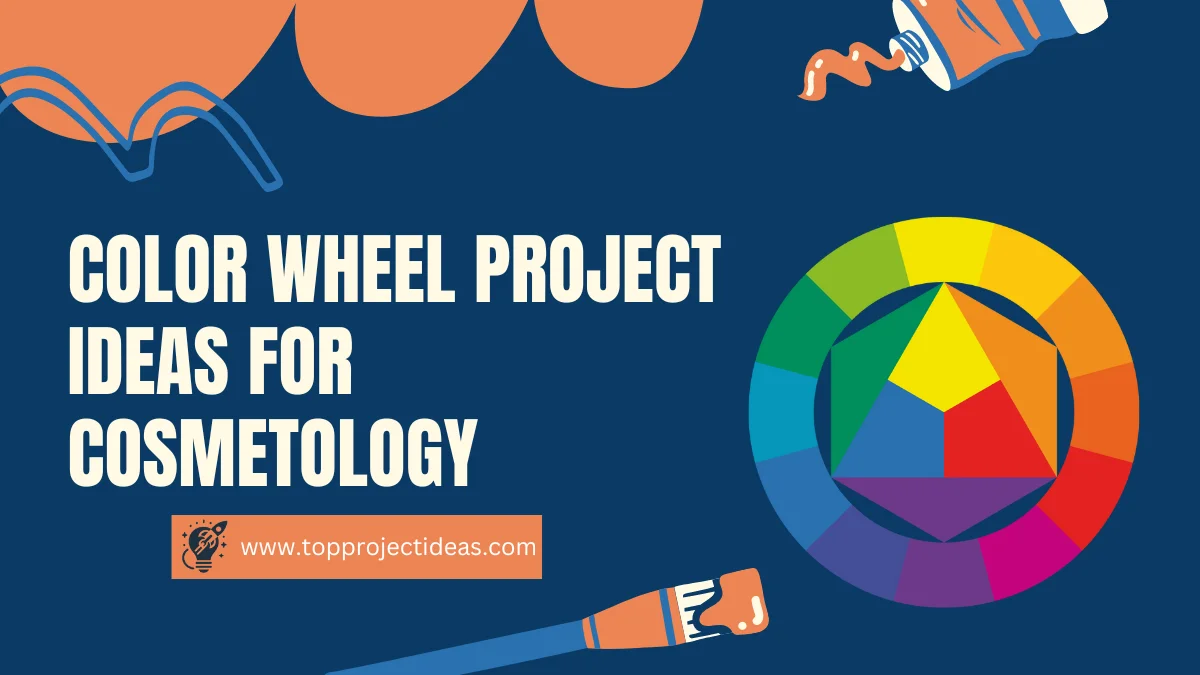A color wheel organizes diverse colors in a ring. The primary colors are yellow, blue, and red. Mixing two primary colors produces secondary ones. Complementary colors occupy opposite ends of the wheel.
Color wheel projects can serve as an excellent tool to help cosmetology students understand how colors work. Understanding the color wheel is important while trying to match hair, make-up, or clothes, for different clients.
Just have fun with this crucial concept! Let us now see what’s trending concerning a color wheel project idea in cosmetology.
You May Be Interested in 61+ Pythagorean Theorem Spiral Project Design Ideas (2024)
What is the Color Wheel in Cosmetology?
In cosmetology, the color wheel is a tool used to understand and choose colors. Here are some basics:
Color Wheel Basics: It’s a circular diagram that shows different colors arranged by their similarity. It displays primary, secondary, and tertiary colors.
Primary Colors: Red, blue, and yellow. All these colors cannot be made by mixing different colors.
Secondary Colors: Green, orange, and purple. Made by mixing two primary colors (for example, blue + yellow = green).
Tertiary Colors: Colors made by mixing a primary color with a neighboring secondary color (for example, red + orange = red-orange).
Complementary Colors: Colors that are opposite each other on the wheel (for instance, red and green). When combined, they cancel each other out to make a neutral color like grey or brown.
Analogous Colors: Colors next to each other on the wheel (for example, blue, blue-green, green). They blend well together and look harmonious.
Uses in Cosmetology: Helps in choosing makeup, hair dye, and clothing colors that complement each other. Assists in neutralizing unwanted tones (for example, using green to cancel out redness in skin).
Practical Example: If you want to reduce redness in the face, use a green concealer because green is the opposite of red on the color wheel.
Understanding the color wheel helps cosmetologists create balanced and aesthetically pleasing looks.
6 Tips For Choosing Your Color Wheel Project Ideas For Cosmetology
As we all know choosing color wheel projects for cosmetology can be fun and creative. Here are six tips to help you pick the right ideas effectively.
- Consider Your Skin Tone: Consider how different colors complement your skin tone. Warm tones match well with oranges, reds, and yellows.
- Think About the Occasion: Different events call for different color combinations. Bold looks can use complementary colors like blue and orange, while natural looks suit analogous colors like shades of pink and purple.
- Experiment with Monochromatic Looks: Try using different shades of the same color for a cohesive look. For instance, a smokey eye with shades of gray can be chic and sophisticated.
- Incorporate Analogous Colors: Colors next to each other on the color wheel blend well together. For warmth, consider shades of pink, red, and orange.
- Don’t Be Afraid to Mix and Match: While guidelines are helpful, feel free to mix and match colors uniquely. Experiment with combinations to find what suits you best.
- Consider the Overall Look: Consider the complete look you want. Balance bold makeup with subtle hair color or nail art.
Exploring color combinations using the color wheel can lead to stunning and unique looks in cosmetology. Enjoy experimenting with colors, and don’t hesitate to leave your comfort zone!
New Color Wheel Project Ideas For Cosmetology In 2024
List of the top-rated color wheel project ideas for cosmetology:
- Hair color wheel mobile with dyed hair extensions showcasing primary, secondary, and tertiary colors.
Key points
- Showcase hair coloring techniques.
- Highlight color relationships.
- Split-face makeup demonstrating complementary colors on each half.
Key points
- Demonstrate color balance.
- Visually represent complementary color effects.
- Mannequin heads displaying different colored wigs styled into historical eras.
Key points
- Explore color trends in history.
- Connect color to fashion.
- The color wheel cake is adorned with frosting in primary and secondary colors, and makeup brushes are used as decorating tools.
Key points
- Creative and playful approach.
- Reinforces color theory.
- Client profile collages featuring magazine cutouts showcasing ideal hair and makeup colors based on skin tone and eye color.
Key points
- Personalize color theory.
- Demonstrate client consultation process.
- Dress a client photo in different colored outfits digitally to illustrate the impact of clothing color on skin tone.
Key points
- Highlight color harmony between clothes and makeup.
- Utilize technology integration.
- Color wheel puzzle with makeup product pictures as pieces – foundation, lipstick, eyeshadow.
Key points
- An interactive learning tool.
- Reinforces understanding of color categories.
- The makeup kit has a color wheel motif and compartments labeled for warm, cool, and neutral tones.
Key points
- Organization and color theory combined.
- Practical application.
- Comic strip depicting a client’s color transformation journey, with speech bubbles explaining color choices.
Key points
- Storytelling approach.
- Simplifies color consultation process.
- Fabric swatches in various skin tones are arranged around a color wheel with color-coded makeup recommendations.
Key points
- Focus on foundation matching.
- Creates a visual guide.
- Mannequin hand with painted fingernails in analogous color schemes, such as blue, purple, and teal.
Key points
- Explore color harmony within a color family.
- Showcase nail art techniques.
- Makeup brush bouquet with bristles dyed in complementary or split complementary color combinations.
Key points
- Artistic and eye-catching.
- Emphasizes color relationships.
- Color wheel board with before and after client photos showcasing successful color corrections.
Key points
- Demonstrate color correction techniques.
- Visually represent client satisfaction.
- Infographic on a color wheel explaining how to neutralize unwanted hair tones with color theory.
Key points
- Educational and informative.
- Simplifies color correction concepts.
- Client mood board with color swatches and magazine cutouts representing their desired hair and makeup look.
Key points
- Collaborative color selection process.
- Emphasizes understanding client preferences.
Importance Of Color Wheel Project Ideas For Cosmetology
Color is vital in cosmetology; knowing the color wheel can help create beautiful looks. These project ideas aren’t just exercises but are essential for cosmetology careers. Here are the top reasons why this idea matters a lot:
- Enhancing Color Harmony
- Projects teach combining colors for visually appealing looks.
- Learning about complementary colors (opposites) helps create balanced makeup.
- Developing Creativity
- It encourages thinking outside the box and trying new color combinations.
- It helps students develop a unique style for their careers.
- Understanding Color Psychology
- Colors evoke emotions and moods.
- Studying the color wheel helps create looks that match clients’ desired feelings or events.
- Improving Technical Skills
- Projects involve blending, shading, and color placement.
- These skills are crucial for professional makeup, hair, and nail results.
- Building a Diverse Portfolio
- Completing various projects showcases versatility and abilities.
- It makes students more appealing to employers or clients.
- Staying Current with Trends
- Beauty trends change often.
- Understanding the color wheel helps students create modern, trendy looks for clients.
Thus, embracing color wheel projects is essential for cosmetology students to understand color theory, enhance creativity, and excel in their careers.
5 Steps To Successfully Execute A Color Wheel Project Ideas For Cosmetology
Successfully executing a color wheel project in cosmetology needs planning and attention to detail. These projects display creativity and an understanding of color theory. Here are five steps to help you:
- Choose a Color Scheme:
- Pick a scheme that fits the project’s theme.
- Use complementary colors for bold contrast or analogous for a harmonious effect.
- Gather Supplies:
- Make a list of needed supplies.
- For makeup, gather various shades of eyeshadow, lipstick, and blush.
- For hair color, get dye and tools.
- Nail art needs different polishes and tools.
- Practice Techniques:
- Practice on a mannequin or model.
- Focus on blending, shading, and placement for a polished result.
- Execute the Project:
- Follow your plan carefully.
- Take your time for precision and adjust as needed.
- Document and Evaluate:
- Take photos or videos of your work.
- Use them for your portfolio.
- Evaluate your work for strengths and areas to improve.
- Seek feedback from instructors or peers.
Executing a successful color wheel project in cosmetology involves planning, attention, practice, and evaluation. Follow these steps to create stunning looks and improve your cosmetology skills.
Final Words
Have fun with cosmetology and explore your creativity! In order to express the artistic self inside you, how about preparing a color wheel with the help of colorful ribbons, candies or make- up? Do you want something practical? Draw a chart of matching colors for hair dye or makeup. Want to be fancy?
Make a beautiful color wheel wreath that will grace your office. No matter who you are, there is always a project on the color wheel that can lighten up your day and also enhance your skills in cosmetology! Thus pick up your tools and begin these simple projects on the color wheel for cosmetology!
FAQs
How can my color wheel project reflect client consultation?
Make a split color wheel with warm and cool colors. Then, add client photos with color recommendations.
What if I’m not artistic? Are there simpler color wheel project ideas?
Yes! Make a color wheel chart with hair colors or makeup looks for different seasons (spring, summer, etc.)
Can I use recycled materials for my color wheel project?
Absolutely! Use old magazines or paint samples to create a collage-style color wheel.

I’m Isla Campbell, a creative and passionate professional with over 8 years of experience in education and project-based learning. I enjoy coming up with smart, helpful project ideas that inspire students and support teachers. I’m skilled at doing research, finding what works best, and turning ideas into successful learning experiences. I also love working with others, staying organized, and making sure every project is done well and on time. Let’s team up to turn great ideas into real results!
